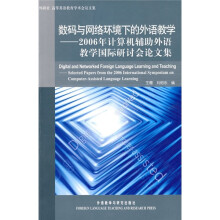Keynote Speeches
Teacher Education in CALL: The Seven Central Questions
Making CALL Research Count: Criteria for Identifying Productive ResearchAgendas
An Ecological Model of E-learning in a Chinese Context: Critical Reflections ofFive Years Practice of E-learning Management in the BIOE
Chinese Learner Corpora and Second Language Research
Social Computing and CALL
Teachers in CALL
Tutor Feedback in Online English Language Learning: Tutor Perceptions
Autonomous Learning and Face-to-face Tutoring in Computer-assisted College English in China--An Explorative Study in Beijing University of ClothingTechnology
An Investigation into a Chinese College TESOL Context
Action Research, a Methodological Approach to the Study of CALL
A Case Report of Web-enhanced Language Learning (WELL) for EFL Teachers
Learners in CALL
A Comparison of the Usage of English TenSes by Undergraduate Students of Different Levels of Ability Receiving Different Types of Error Treatmen Through the Use of Computer-assisted Language Learning
Attitude and Behavior study in Web-based Language Learning
Students Perceptions of the Effect of Interaction in Web-based Courses onStudent Outcomes
Hypermedia Annotation Preferences and Their Effects on Reading Comprehensionby English-major Students
Instructional Design and Material Evaluation
Designing Foreign Language Instruction Delivered at a Distance: Learner Considerations
The Design of EFL Multi-media Materials in Assisting Listening Comprehension
Technologies in CALL
Blogging: Voices Need an Audience
Concordancers and Synonym Learning: A Between-group Research
The 90 Percent Solution: The Case for English Language Learning with Mobile Phones
Supporting Student Learning on an International Campus
Testing and Assessment in CALL
Formative Assessment Notions in Email-based Language Learning: A Case Analysis
Corpus-based Studies
A Corpus-based Study of Connectors: Research from the CAS Learner Corpus of English Essays
Amplifier Collocations in the Chinese Learner English Corpus
Spoken Language Learned from Textbooks and Evidenced in CANCODE
Rhetoric Structure of the Coalesced Results and Discussion Section: A Corpus-based Comparative Study via NVivo 2.0

 缺书网
缺书网 扫码进群
扫码进群





